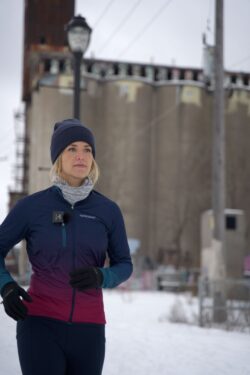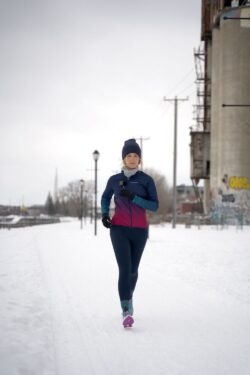Catherine Senez, PT, and Gabrielle Picard, writer, Nxt Generation PHYSIO
Running in winter can be beneficial for your physical and mental health, but it also carries risks. Winter running requires adjustments and proper preparation.
Here are the tips and warnings from our physiotherapist for enjoyable and safe winter running outings.
ADAPT TO YOUR ENVIRONMENT
In winter, several components of your running environment can change. You need to be familiar with your surroundings and adapt accordingly to the risks it may present.
The running surface can be variable in winter.
It can be more slippery due to the presence of ice and snow. It can also be uneven due to snow accumulation, which increases the risk of falling. Having shoes with spikes or cleats is essential to reduce the risk of injuries and provide better traction on icy or snowy surfaces.
The temperature is colder.
The cold weather will impact your running habits and tends to increase your energy demand. Frostbite, hypothermia, and respiratory issues are risks for some runners. It is important to know your limits and exercise caution in such conditions.
Vos besoins seront différents.
La soif est moins ressentie lorsqu’il fait froid. Il est alors primordial d’être à l’écoute de son corps pour éviter la déshydratation et/ou l’hypothermie.
DON’T NEGLECT THE IMPACT OF YOUR HEALTH ON YOUR ABILITY TO RUN IN WINTER
Some health issues can make winter running challenging. It’s important to consider your health condition before heading out for a run.
Respiratory health problems like asthma can cause discomfort when running in winter. Using a hood or a neck gaiter to cover your mouth and nose can help facilitate breathing.
It’s also important to reduce the volume and intensity of your workouts in winter, as winter running requires more effort. Maintain a safe heart rate and avoid pushing yourself beyond your body’s limits.
If you have balance issues, be extra cautious due to the increased risk of falls during winter running.
Remember to listen to your body and prioritize your health and well-being above all else. If you have any concerns or doubts about your ability to run in winter, consult with a healthcare professional for personalized guidance.
What are the benefits of winter running?
If you’re someone who enjoys outdoor running during the summer, I highly recommend continuing to run outside during winter, as long as the weather conditions and your physical condition allow it.
In addition to getting fresh air, running outdoors provides training benefits that are different from running on a treadmill or an indoor track. When running outdoors, you have to propel yourself forward, whereas on a treadmill, the belt moves beneath you, creating a completely different muscular demand. The uneven terrain outdoors also stimulates your balance reactions, further enhancing your overall stability.
HOW TO PROPERLY PREPARE FOR A RUNNING SESSION
Adjust your running goals:
Given the changing weather conditions (temperature, ice, snow, etc.), it’s important to adjust your running parameters (volume and intensity) accordingly. Lowering these parameters will allow your body to adapt to the new conditions, and you can gradually return to your usual settings.
Adapt your route and training days:
Prioritize safer routes, opt for less icy and snow-free surfaces, and choose well-lit paths. Take into account the temperature and weather conditions when planning your run.
Modify your warm-up routine:
Your warm-up should be longer than usual to adequately prepare your body for the effort ahead. Incorporate dynamic stretches and movements to activate your muscles and joints.
Adjust your running technique:
To adapt to winter conditions, shorten your stride length while increasing your cadence. This adjustment can improve stability and reduce the risk of slipping.
Wear the right gear:
- Shoes: Choose shoes with good traction and waterproofing. Avoid mesh ventilation panels as they can lead to wet and cold feet. Gore-Tex shoes are a popular choice for waterproofing and keeping your feet dry. If you don’t want to invest in a new pair of shoes, you can purchase shoe traction devices that can be added to your regular running shoes.
- Clothing: Master the art of layering! Use moisture-wicking fabrics and avoid cotton, which retains moisture. One essential clothing item, according to our physiotherapist, is pants with wind-resistant panels on the thighs. They help block the headwind while allowing airflow. At the beginning of your run, it’s recommended to feel slightly cold to ensure you won’t overheat as your body warms up during exercise.
- Safety: Ensure visibility. During winter months, visibility can be reduced due to weather conditions and shorter daylight hours. Avoid accidents by wearing reflective bands and using lights to make yourself more visible to others.
However, before starting any new physical activity, it’s always advisable to consult with a physiotherapist to prepare your body for the specific demands of running and to ensure you’re in good physical condition.
Schedule an appointment with our team of experts to prevent injuries and maximize your physical performance.



